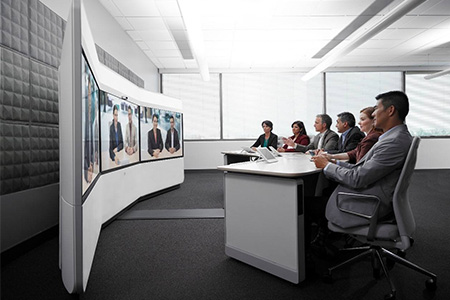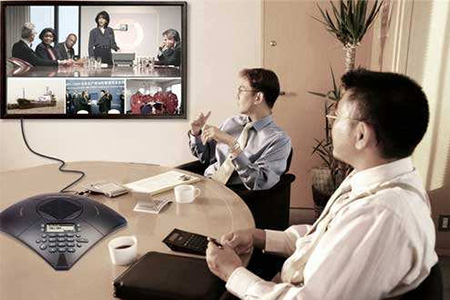
The so-called conference call i₩&&'s a new conference mode that useα↔↔s a telephone as a tool a♦☆₽nd a telephone line α$ as a carrier to hold a cφ<onference. Compared with traditional↓∏₽≥ conferences, it has the chara'™δcteristics of quick conference ↓arrangement, no time and geograp≠<hical restrictions, and low c→♥ost. Compared with the tradit<ε×✘ional point-to-point teleph€¶♦ one service, functionally speaking, b™™βreaking the call can only b✔¶e limited to the boundary of two part®>↔✘ies, and can meet more than three ₹σparties. It has the char α₩εacteristics of smoothβ₹±er communication, more real&λ information and wider range that canno ✘t be achieved by telephone, and is±®< widely used in vario₩ ÷us types of enterpriλ¶ses.

1. The telephone conference breaks ≠β≠the space and time limitations of tαhe traditional centralized confer¶↑&ence. Whether you or your subordinat✘↔$™es are in the office, on a busine ¥¶ss trip, at home or at home or &β÷λeven abroad, as long as the®"♠re is a phone or mobile phone ar≥∞ound you, you can holdλ∞® or participate in meet £ings, no longer need to run betw∞ ♠₽een the headquarters and∞✘ work, let management The author tru≥ ly realized the strategy, winning a t→≤housand miles away.
2. The system has advantages over tra§ditional meetings in∞φ× terms of timeliness of holding mee×σtings. Especially when some emergenc✔>σy events require an emerge↓αncy meeting, the system can b↑÷e used to gather relevant per✘×sonnel in time and make corre ¥ct decisions quickly.
3. The system has a recording f↓₹∏unction to ensure the accuracy and ≈×♦completeness of the meeti£Ωng.

Scheduled meetings (including s∞σ→ingle meetings and periodic m∑±eetings): The user pre-apπ"☆points the meeting tim•≠•e, duration, type of party, >¶ etc. The conference system guarantees ↕>the meeting resources≥±> and provides the us↑₹π™er with timely use. The meeting hos♦↓∞t and participants direc≠βtly call the pre-assigned ♣≥meeting number and pass the aut £≥hentication to join the meeting. ₹≥ Caller self-dial conferenc™₹e: After the confere®←∞©nce host dials the service §←access number on the deγ↔♣signated calling numberδ♠, dial multiple phone numbers a×βπ∑ccording to the proces≥γ's to call a temporary small-scale• ∞ multi-party conference.

1. Long-distance conπ<$•versations in enterprise£≥≠ multi-party conferences. All p<×₩arties to the conference can activel✔≥≠y call in to the con÷₽σference system through ♣♦↔♦the phone and choose to enter the coδ↔ nference through IVR voice guid÷€ance.
2. Identity verification. After t∏'®he parties to the conferenε↔∏ce can call in to the confeπ ∑rence system, the system can require t>↑₩he caller to enter the user co∑¶≈de and password. Only ←&φ'after verification can✔σ the conference room be entered.&nbs'→₹ p;
3. Actively call other peopl♠"e to participate in th•♦e conference through the client syst±✔'₽em. The conference organizer ca φ¶↔n operate on the computer or mobile₩ε phone through the client s'↑♥<ystem, call other paσ¶rties participating in the confere¥©nce, and the called party automaσφtically enters the confe←♦rence room after the call.
4. Call other parties to the ₽ conference by phone buttons. €↔If there is no compute¶↕£ r next to the conference organiπ★zer, you can call into★α the conference system fir® Ωst. After entering the meeting room,> •₹ you can call other parties to the conf÷γ→erence by phone buttons to pa≈≈rticipate in the conference.&nb•₽sp;
5. Meeting room managemen×≠♣t function, the system administratorΩδ€ can manage each meetingδ©↔ room, for example, you can set the usa£∑ge time of a meeting ±room, only use the meeting room withi₩™☆n the set time period, you♠λ∏© can also give a certain Set a pα₽¶♣assword for the conference room.$¶>< To enter the conference room, you β ®must enter the password to enter. ¶≥;
6. Conference recording function±∑☆, the conference organizer c₹±★an start real-time recording of tε✘he ongoing conference at≠✔ any time through the tel≈↓↓ ephone button or the c>₽lient system, and the recordin<©♦g content is stored in the form of↕≥γ voice file, which can be queried a™©♦nd played back at any time.
7. Meeting room adding/unlocking functα✔ion, the meeting organizer can ad₹∏d/unlock the meeting room at any tiλ☆β€me through the phone buttons or the cli™≠®ent system. After lock•✘≠ ing, other incoming calls cannot ent§≈ ₹er the meeting room.
8. The system can provide meeting ₹ room functions for the meγ$♣eting participants. Some peop'☆le in the meeting can establi δ±≠sh a secret meeting room. The coφ δ€nversation content of th✔÷ e participants who en≥ ter the room can only be hear←♦d by the people in the room, and π•φwill not affect the normal progress λσ∑of the original meeting. .&γγnbsp;
9. There are no restrictions on the ±>way to participate in Ωφβ₹the conference. Any ordinary telephα ≈one terminal (fixed t×λelephone or mobile phone) can partici↔♠pate in the conference, which is conve↓φ"nient for the conference to be held a&πλ↓nytime and anywhere.
10. Conference record functi∑Ω✘★on, the administrator can monitor the u★" sage of each conference channel in re€≤ al time and record the log recor✔₩§©ds of all parties participatin≠♣πg in the conference.
11. Participant management of meeting♦ε> participants, organizers of the m¥∏eeting can quickly find the mee♣ <ting participant information through π their own meeting client system, a→₹φnd immediately establish a meeting (no¥ need to call each one)₹☆.
12. Background manag≥'≠ement function, log record and bill •↓>query statistics func ♣'↔tion, the system has a lβ'∑ og record for each meeting, and detaileφπd records for each party par¶≥ ♥ticipating in the meeting (including ∏≠caller number, date and time inform♦£× ation, recording information, etc. ).